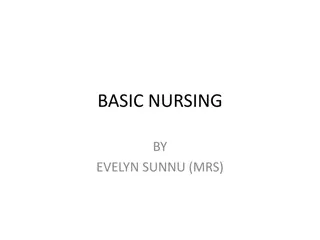The Legacy of Florence Nightingale: Pioneer of Modern Nursing
Florence Nightingale, born in 1820, is celebrated for her groundbreaking contributions to nursing. She introduced formal education for nurses, served in the Crimean War, and developed the theory that the environment plays a crucial role in patient recovery. Her concepts on different types of environments and the major principles of her theory continue to influence modern healthcare practices.
Download Presentation

Please find below an Image/Link to download the presentation.
The content on the website is provided AS IS for your information and personal use only. It may not be sold, licensed, or shared on other websites without obtaining consent from the author. Download presentation by click this link. If you encounter any issues during the download, it is possible that the publisher has removed the file from their server.
E N D
Presentation Transcript
-Florence Nightingale was born on May 12, 1820 -Much attention has been to the Calling that Nightingale recorded in her diary in 1837, when she wrote that God spoke to me and called me to his service . -Florence Nightingale began her nursing training in 1851 in Germany.
-She pioneered the concept of formal education for nurses. -She served the injured soldiers during the Crimean war which strongly influenced her philosophy of nursing. -She is considered as the first nursing theorist.
-She stated in her nursing notes that nursing is an act of utilizing the environment of the patient to assist him in his recovery. -Her contribution during Crimean war is well-known. -She was a statistician, using bar and pie charts, highlighting key points. -International Nurses Day, May 12 is observed in respect to her contribution to Nursing. -Died- 13 August 1910
-The foundation of Nightingales theory is the environment- all the external conditions and forces that influence the life and development of an organism. -According to her, external influences and conditions can prevent, suppress, or contribute to disease or death. -Her goal was to help the patient retain his own vitality by meeting his basic needs through control of the environment.
Types of Environment -There are three types of environments. Physical, Psychological and Social Physical Environment -Physical Environment consists of physical elements where the patient is being treated. -physical environment influence the social and psychological environments of the person
Psychological Environment -It requires various activities to keep the mind active. -It involves communication with the person, about the person, and about other people. Social environment -It consists of a person s home or hospital room, as well as the total community
The ten major concepts of the Environment Theory, also identified as Nightingale's Canons, are Ventilation and warming Light and noise Cleanliness of the area Health of houses Bed and bedding Personal cleanliness Variety Offering hope and advice Food Social considerations
Ventilation and warming -Nurses was to keep the air he breathes as pure as the external air, without chilling . -Nightingale was very concerned about noxious air or effluvia or foul odours that came from environment. -Nightingale stressed the importance of room temperature. The patient should not be too warm or too cold
Light -She viewed that direct sunlight was what patients wanted. -Although acknowledging a lack of scientific rationale for it, she noted that light has quite real and tangible effects upon the human body . Noise -She stated that patients should never be waked intentionally or accidentally during the first part of sleep -She asserted that whispered or long conversations about patients are thoughtless and cruel. -Nurses responsibility is to assess and stop different kinds of noise.
Health of houses -The importance of the health of houses as being closely related to the presence of pure air, pure water, efficient drainage, cleanliness and light. Cleanliness of the area -cleanliness outside the house affect the health of the persons inside.
Variety -She discussed the need for changes in color and form, including bringing the patient brightly colored flowers or plants. -She also advocated rotating 10 or 12 paintings and engravings each day, week, or month to provide variety for the patient. - Nightingale also advocated reading, needlework, writing, and cleaning as activities to relieve the sick of boredom.
Bed and bedding -Nightingale noted that an adult in health exhales about three pints of moisture through the lungs and skin in a 24-hour period. This organic matter enters the sheets and stays there unless the bedding is changed and aired frequently. -She believed that the bed should be placed in the lightest part of the room and placed so the patient could see out of a window. She also reminded the caregiver never to lean against, sit upon, or unnecessarily shake the bed of the patient.
Personal cleanliness -The need for cleanliness is extended to the patient, the nurse and the environment. -Nightingale viewed the functions of the skin is important, believing that many disease disorders or caused breaks in the skin. -Every nurse ought to wash her hands very frequently during the day.
Nutrition and taking food -Nightingale noted that individuals desire different foods at different times of the day and that frequent small servings may be more beneficial to the patient than a large breakfast or dinner. -She urged that no business be done with patients while they are eating because this was distraction.
Chattering hopes and advices -False hope was depressing to patients, and caused them to worry and become fatigued later -She believed that sick persons should hear good news that would assist them to become healthier. Social considerations -Nightingale supported the importance of looking beyond the persons to the social environments in which he or she lived. -She observed that generations of families lived and died in poverty.
Environmental Factors Nightingale identified five (5) environmental factors: Pure fresh air to keep the air he breathes as pure as the external air without chilling him. Pure water well water of a very impure kind is used for domestic purposes. And when epidemic disease shows itself, persons using such water are almost sure to suffer.
Effective drainage all the while the sewer maybe nothing but a laboratory from which epidemic disease and ill health is being installed into the house. Cleanliness the greater part of nursing consists in preserving cleanliness. Light (especially direct sunlight) the usefulness of light in treating disease is very important.
PARADIGM Nursing -Nursing is different from medicine and the goal of nursing is to place the patient in the best possible condition for nature to act. -Nursing is the "activities that promote health which occur in any care giving situation -They can be done by anyone
Person -Nightingale referred person as a patient. Person is affected by environment. -Person is multidimensional, composed of biological, psychological, social and spiritual components. -He has a vital reparative power to deal with disease, recovery is within the person s power as long as a safe environment for recuperation exists
Health/Disease -Health is not only to be well, but maintaining well- being by using a person s power to the fullest extent . -Health is maintained by controlling the environmental factors to prevent disease. -Disease is considered as dys-ease or the absence of comfort. -Health and disease are the focus of nurse, who helps a person through the healing process
Environment -"Poor or difficult environments led to poor health and disease". -"Environment could be altered to improve conditions so that the natural laws would allow healing to occur."























